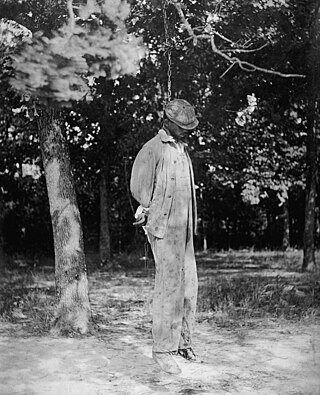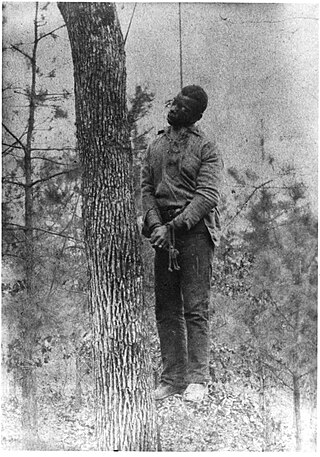
"Flash Crowd" is a 1973 English-language novella by science fiction author Larry Niven, one of a series about the social consequence of inventing an instant, practically free displacement booth.

Lynching is an extrajudicial killing by a group. It is most often used to characterize informal public executions by a mob in order to punish an alleged transgressor, punish a convicted transgressor, or intimidate people. It can also be an extreme form of informal group social control, and it is often conducted with the display of a public spectacle for maximum intimidation. Instances of lynchings and similar mob violence can be found in every society.

Critical Mass is a form of direct action in which people travel as a group on bicycles at a set location and time. The idea is for people to group together to make it safe for each other to ride bicycles through their streets, based on the old adage: there's safety in numbers.

A smart mob is a group whose coordination and communication abilities have been empowered by digital communication technologies. Smart mobs are particularly known for their ability to mobilize quickly.
An anti-social behaviour order is a civil order made in the United Kingdom against a person who had been shown, on the balance of evidence, to have engaged in anti-social behaviour. The orders were introduced by Prime Minister Tony Blair in 1998, and continued in use until abolished in England and Wales by the Anti-Social Behaviour, Crime and Policing Act 2014 on 20 October 2014—although they continue to be used in Scotland and Northern Ireland. ASBOs were replaced in England and Wales by the civil injunctions and criminal behaviour orders. They were designed to address behaviours like intimidation, drunkenness, and violence by individuals and families, using civil orders rather than criminal sanctions. The orders restricted behaviour in some way, such as: prohibiting a return to a certain area or shop; or restricting public behaviours, such as swearing or drinking alcohol. Many saw the ASBOs as connected with young delinquents.
Flash mob computing or flash mob computer is a temporary ad hoc computer cluster running specific software to coordinate the individual computers into one single supercomputer. A flash mob computer is distinct from other types of computer clusters in that it is set up and broken down on the same day or during a similar brief amount of time and involves many independent owners of computers coming together at a central physical location to work on a specific problem and/or social event.
A home invasion, also called a hot prowl burglary, is a sub-type of burglary in which an offender unlawfully enters into a building residence while the occupants are inside. The overarching intent of a hot prowl burglary can be theft, robbery, assault, sexual assault, murder, kidnapping, or another crime, either by stealth or direct force. Hot prowl burglaries are considered especially dangerous by law enforcement because of the potential for a violent confrontation between the occupant and the offender.

A pillow fight flash mob is a social phenomenon of flash mobbing and shares many characteristics of a culture jam.

Lynching was the widespread occurrence of extrajudicial killings which began in the United States' pre–Civil War South in the 1830s and ended during the civil rights movement in the 1950s and 1960s. Although the victims of lynchings were members of various ethnicities, after roughly 4 million enslaved African Americans were emancipated, they became the primary targets of white Southerners. Lynchings in the U.S. reached their height from the 1890s to the 1920s, and they primarily victimized ethnic minorities. Most of the lynchings occurred in the American South, as the majority of African Americans lived there, but racially motivated lynchings also occurred in the Midwest and border states. In 1891, the largest single mass lynching in American history was perpetrated in New Orleans against Italian immigrants.

A pantsuit, also known as a trouser suit outside the United States, is a woman's suit of clothing consisting of pants and a matching or coordinating coat or jacket.

A political demonstration is an action by a mass group or collection of groups of people in favor of a political or other cause or people partaking in a protest against a cause of concern; it often consists of walking in a mass march formation and either beginning with or meeting at a designated endpoint, or rally, in order to hear speakers. It is different from mass meeting.
Bill Wasik is the editorial director of The New York Times Magazine, and self-proclaimed originator of the flash mob.
Crowd manipulation is the intentional or unwitting use of techniques based on the principles of crowd psychology to engage, control, or influence the desires of a crowd in order to direct its behavior toward a specific action. This practice is common to religion, politics and business and can facilitate the approval or disapproval or indifference to a person, policy, or product. The ethicality of crowd manipulation is commonly questioned.
The Bonanno crime family is an Italian-American Mafia crime family and one of the "Five Families" that dominate organized crime activities in New York City, and in the United States, as part of the criminal phenomenon known as the American Mafia.
A flash rob, also known as a multiple offender crime or flash mob robbery, is an organized form of theft in which a group of participants enter a retail shop or convenience store en masse and steal goods and other items. Typically, store workers and employees in these cases quickly become overwhelmed by the large number of participants and cannot stop the theft.
Humsafar Trust is an NGO in Mumbai that promotes LGBT rights. Founded by Ashok Row Kavi, Suhail Abbasi, and Sridhar Rangayan in 1994, it is one of the largest and most active of such organisations in India. It provides counselling, advocacy and healthcare to LGBT communities and has helped reduce violence, discrimination and stigma against them. Humsafar Trust is the convenor member of Integrated Network for Sexual Minorities (INFOSEM).

Art Cluster, in global contemporary art scene, refers a group of artists that work through Internet to promote the free culture and many artistic values. The emerging telecommunications have developed a new form of communication, much faster and more direct. This allows people to work from anywhere in the world. People can easily group or perform any type of organization. Art Cluster also refers artistic production of collective intelligence. The integration of social movement in the cyberspace is one of the potential strategies of this social movement.
Memphis, Tennessee serves as the Southern headquarters for Tennessee based street organizations in the Southern United States. In 2021, there were approximately 102 gangs with 13,400 gang members in the city.
A flash mob is where a group of people rapidly gather and perform an unusual and pointless act and then quickly disperse.

Shortly after protests seeking justice for George Floyd, an African American who was murdered during a police arrest, began in the United States, the people of Italy also began to protest to show solidarity with the Americans.












